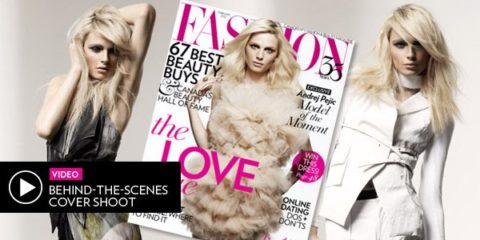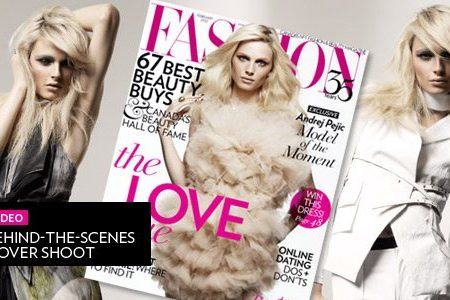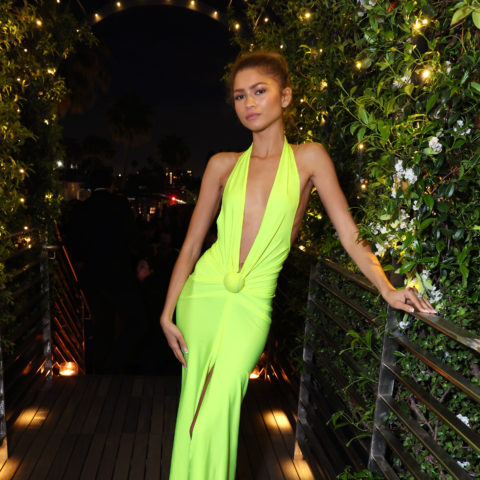Andrej Pejic: Our cover shoot, interview, and behind the scenes video with the androgynous star


He’s no lady. Boy wonder Andrej Pejic brings his dry wit and supermodel moves to the top Canadian designs for spring.
Watch our video with Andrej Pejic »
Read our interview »
Cover story: Boy Meets Girl
By Rani Sheen
The model of the moment is gorgeous, leggy and pillow-lipped. Oh, and he’s a man. Can we handle that?
When Andrej Pejic and I walk into Toca restaurant at the Ritz-Carlton in Toronto, the chipper hostess greets us warmly: “Welcome, ladies. Table for two?”
Pejic, the most talked-about male model of the moment, doesn’t even blink. In town for Spring 2012 LG Fashion Week, the tall, slender 20-year-old with baby-fine white-blond hair and delicate cheekbones is beyond used to being taken for a girl. “Story of my life,” he says drolly. His voice—quite deep, unhurried, Australian-accented—gives the game away. “If I get asked a question, I’ll answer,” he says. “Usually people are amazed. Some of them are like, ‘Sorry,’ and others are even more interested.”
This could serve as a description of the fashion world’s reaction to Pejic. He was born in war-stricken Bosnia and Herzegovina, and his family moved to Serbia and then to Melbourne. In high school, he started to experiment with makeup and hair dye. He was scouted at 17, and on one of his first jobs, he opened a runway show for a womenswear brand at Sydney fashion week. “No one actually noticed that it was me, or not a girl,” he says. He went on to shoot some edgy editorials, but commercial jobs were harder to come by in the small, somewhat conservative market, so his mum borrowed some money for him, and he went to try his luck in London.

Photographed by MOO. Styled by George Antonopoulos.
There, his first round of agency visits met with a chorus of “No, sorry,” in part because he didn’t fit neatly into their menswear or womenswear divisions. “You think fashion is so forward in these terms, and when it comes to someone breaking that order of an organization, suddenly it’s like a big deal or they don’t know how to handle it,” says Pejic. The last agency on his list was Storm, headed by Sarah Doukas, who famously took a chance on a five-foot-seven Kate Moss. Doukas snapped him up. “I guess I’ve always been instinctively drawn to those with character, and those who don’t conform to one physical ideal,” she says.
Soon, super-photographers Mert Alas and Marcus Piggott cast Pejic for a September 2010 Vogue Paris womenswear shoot styled by editor-at-the-time Carine Roitfeld. (“He really looks like a girl, but not in a ‘travesti’ way,” Roitfeld tells me.) He then landed the Marc by Marc Jacobs Spring 2011 campaign, shot by Juergen Teller, playing the shorts-and-sneakers-wearing “boy” to Ginta Lapina’s “girl.” Fully exploiting Pejic’s versatility, Jean Paul Gaultier hired him for his Fall 2011 menswear show (Pejic appeared once in a classic suit and once in a striped fur and gold heels), to walk in his Spring 2011 couture show as a veiled bride, and to pose alongside Karolina Kurkova—the two look strikingly similar—in his spring campaign.
It all adds up to a very promising career start, though some of the buzz may be based, at least in part, on the novelty of Pejic’s “situation,” as he calls it. “I feel like I’ve had to work harder than most girls to prove that I can be a good model,” he says. He’s attracted a great deal of media scrutiny and faces constant queries about his private life: Who does he sleep with? Has he had a sex change? As Toronto certified sexuality educator Cory Silverberg puts it, “The general public do still see people who cross genders as a freak. They want to watch and stare. They want to know what is in his pants.”
Pejic deals with such intrusion by evading some probing questions and answering others playfully. He has joked that he’d consider sex-change surgery for a Victoria’s Secret contract. “The questions are very repetitive and they get really boring,” he says. “And a lot of them are very private—you wouldn’t really ask the other girls or boys that—so I don’t always feel the need to answer them correctly.” He says the U.K. edition of Grazia misquoted him as saying, “I like to dress as a girl but I don’t want to be one.” Generally laidback about the media, he was annoyed by it because “I never really make sweeping statements like that.”
Many people first heard of Pejic last May when U.S. bookstore chains decreed that an issue of Dossier magazine must be covered in opaque wrap because customers might confuse a shirtless Pejic on the cover for a woman. “What are we being protected against?” asks Silverberg. “What is more frightening to people than nude male or female bodies are bodies that call gender into question…It’s the middle space that is threatening.”

Photographed by MOO. Styled by George Antonopoulos.
This middle space has been occupying the cultural sphere of late, particularly the intense interest in (and judgment of) parents who allow or encourage their young children to contradict gender stereotypes. Exhibits a, b and c: the Toronto couple raising a “genderless child”; J.Crew president and executive creative director Jenna Lyons’ decision to paint her son’s toenails pink; Angelina Jolie allowing her daughter Shiloh to wear boys’ clothes.
As well, androgynous fashion is becoming increasingly mainstream. In the past few years, menswear has steadily encroached on womenswear: Perhaps under the influence of Céline and Jil Sander, most fashionable women will have acquired a boxy collared shirt (worn buttoned all the way), a pair of oxford lace-ups and a “boyfriend” blazer. It’s nothing new, of course. Early in the 20th century, Coco Chanel took jersey from the men’s underwear drawer and dressed women in it; in 1966, Yves Saint Laurent played with notions of gendered dressing when he created Le Smoking. “It’s always been a part of fashion,” says Roitfeld. “When Monsieur Saint Laurent dressed a girl in a man’s suit, with no handbag and hair slicked back like a boy, she was still very feminine. Ambiguity is interesting!”
Although Pejic didn’t set out to be a representative of those who fall outside the straight/male/female mainstream, he’s happy to be so if it’s helpful. Ultimately, he’d like people to focus less on divisive categorizations. “I feel like a lot of people in my situation can be [defensive], and I can fully understand that,” he says. “There’s a lot of reason for that, but I don’t think that’s the way to solve it at the end of the day. I don’t think it’s about reinforcing the differences or even idolizing them. I think it’s about moving past them.”
Silverberg points out that there is beauty in those differences, but says Pejic has an important role to play in increasing public awareness and empathy. “To connect with people and get people to engage with those differences, to see that those differences aren’t so scary that we need to eliminate them, we need people to bridge those divides.” But he takes care to point out that increased awareness doesn’t mean that life will improve for everybody. “It’s not that it’s easy now, that everyone can be who they are. Right now the violence against people who are transgender is still intense.”
Gender politics aside, if that were even possible, can Pejic turn his moment in the spotlight into a long-term career? Doukas thinks so.
“Traditional modelling careers don’t really exist anymore,” she says. “The real stars of today write their own scripts.” For his part, Pejic would like to write an autobiography (“It’s been an interesting life,” he says), explore TV opportunities and later study law at university.
But for now, it’s all fashion, all the time. As we wrap up, I ask if he takes a different approach to modelling womenswear and menswear, and he gently lets me know that I’ve reduced things too far. “It’s not just about being one dimension,” he says. “There’s more to the story than that.”







